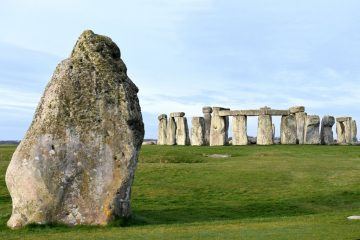Franz Lidz in The New York Times:
 Back in the ’30s — the 1130s — the Welsh cleric Geoffrey of Monmouth created the impression that Stonehenge was built as a memorial to a bunch of British nobles slain by the Saxons. In his “Historia Regum Britanniae,” Geoffrey tells us that Merlin, the wizard of Arthurian legend, was enlisted to move a ring of giant mystical stones from Mount Killaraus in Ireland to what is commonly believed to be Salisbury Plain, a chalk plateau in southern England, where Stonehenge is located. Back in the ’50s — the 1950s — a chunk of rock went missing from the magical tumble of megaliths that now compose Stonehenge. The chunk, a three-and-a-half-foot cylindrical core, had been drilled out of one of the site’s massive sarsen stones during repairs and taken home by an employee of the diamond-cutting firm that carried out the work. The core, recently repatriated after 60 years, turned out to be pivotal to an academic paper published on Wednesday in the journal Science Advances. The study pinpointed the source of the sarsens, a mystery that has long bedeviled geologists and archaeologists.
Back in the ’30s — the 1130s — the Welsh cleric Geoffrey of Monmouth created the impression that Stonehenge was built as a memorial to a bunch of British nobles slain by the Saxons. In his “Historia Regum Britanniae,” Geoffrey tells us that Merlin, the wizard of Arthurian legend, was enlisted to move a ring of giant mystical stones from Mount Killaraus in Ireland to what is commonly believed to be Salisbury Plain, a chalk plateau in southern England, where Stonehenge is located. Back in the ’50s — the 1950s — a chunk of rock went missing from the magical tumble of megaliths that now compose Stonehenge. The chunk, a three-and-a-half-foot cylindrical core, had been drilled out of one of the site’s massive sarsen stones during repairs and taken home by an employee of the diamond-cutting firm that carried out the work. The core, recently repatriated after 60 years, turned out to be pivotal to an academic paper published on Wednesday in the journal Science Advances. The study pinpointed the source of the sarsens, a mystery that has long bedeviled geologists and archaeologists.
Although the project did not identify the specific spot where the stones came from, Mike Pitts, editor of the magazine British Archaeology, believes that the discovery makes the search for sarsen quarries a realistic option. “If we can find them, we could learn about how they were dressed and moved, and importantly we might be able to date that activity,” he said. “Dating matters, because then we can say what else was present in the landscape at the same time, what was old or gone and what was still to come — other sites are better dated — and of course who actually built the thing.”
More here.
